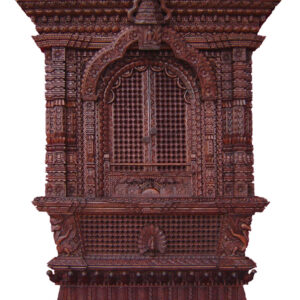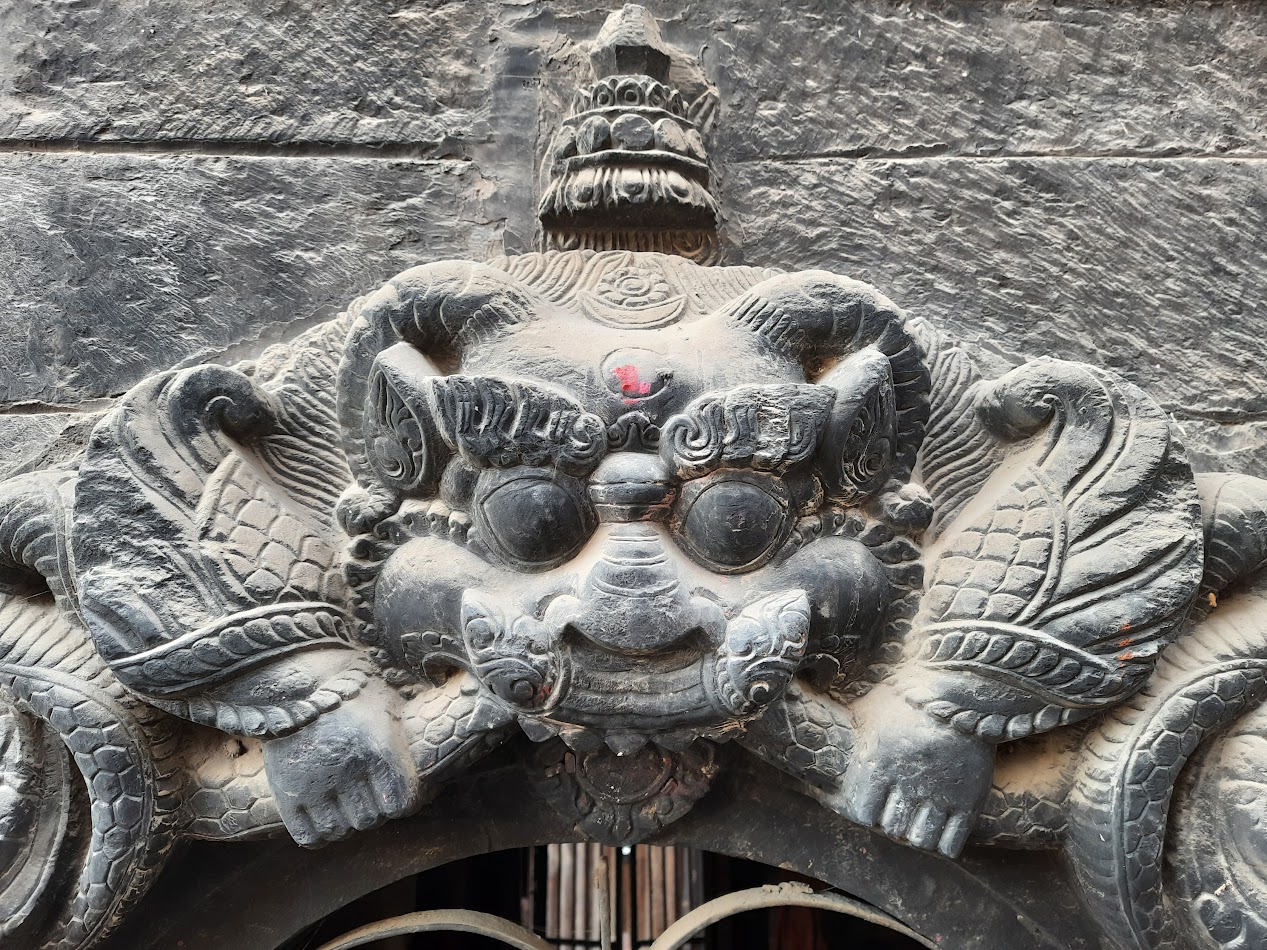Description and Origin of cheppu. Leave a comment

When Kathmandu was a lake, there lived a creature here so grotesque even its own mother could not bear to look at it. Its name was Chhepu. Look above the entrance of any temple in Kathmandu and you will see it posing mid-meal.
Chhepu features in the legend of Kathmandu’s genesis, the one in which a prince named Manjushree cut open a mountainside to drain the lake and build this city. It was an elusive creature, so the story goes. Manjushree did not see it at first. Then, for a moment, it emerged from the water’s surface to feed. He quickly carved its face onto stone or penned it onto paper or something of the sort, but before he could capture its full form, it vanished, never to return again. Repentant, Manjushree had Chhepu’s face displayed above all major doors and gates in the city.
Some say that, in truth, Manjushree banished Chhepu because it was monstrous, and he put its face on top of doors so those who live here know never to let inside one with that face.
Now I may get into trouble with the tourism board for this. But here is what really happened.
There were two siblings at first, Garuda and Makara. Garuda is the one with wings and a beak, the more successful one on account of mention in the Ramayana. Ravana, the villain, had abducted Sita, the princess, and was flying away on some mythical vehicle when Garuda intervened, albeit unsuccessfully. I suppose winged things were a nuisance to pilots long before the animosity between birds and airplane engines.
When Garuda was born, the mother gave the creature rule over the sky. To Makara, she gave rule over water. Testament to this are the old stone water spouts in Kathmandu that are in the shape of Makara’s head, water pouring out of its mouth.
Chhepu was the lastborn. It was born with a serpentine tail for which its powerful siblings tormented it. ‘We will eat your tail,’ they said. Foreseeing suffering in Chhepu’s fate, the mother gave it invisibility. ‘If they eat your tail, you will be seen,’ she warned. No one heard from Chhepu after that until the day Manjushree came to Kathmandu.
It is not known if Manjushree came from the north or the south. Some speculate it was the east. When he arrived, he stood on top of a mountain and saw a bright lotus in the middle of the lake. Seeing it, he said he would drain the lake and build a city at the base of the lotus. As he drew his sword to cut open a mountain side, a voice interfered, ‘Halt.’
‘Who speaks?’ said Manjushree.
‘I am Chhepu.’
‘I do not see you.’
‘Nor shall you.’
‘What is the meaning of this?’ asked Manjushree.
‘Why, prince, do you wish to destroy my home?’
‘I shall drain this lake and build a city here. The land beneath is fertile, so farmers will reap well. Merchants here will trade with the mountains and the plains. It will be a city worthy of gods.’
‘This lake is home to the Naga serpents,’ said Chhepu. ‘If you destroy their home, they will curse it so the soil will become infertile and those who dwell here will suffer diseases.’
‘The Nagas must leave in peace. If they refuse, it will come to war.’
‘People will suffer too,’ Chhepu reasoned.
‘I must build my city,’ said Manjushree. ‘Ask the Nagas to leave. I wish not to be at war with them.’
Chhepu spoke to the Nagas and returned to Manjushree. ‘Many Nagas have agreed to leave and some wish to stay,’ it said. ‘Allow safe passage to all who leave and let the remaining live in your wells, under large rocks, and close to peepal trees.’
Manjushree agreed. After the exodus, Manjushree cut open a gorge at what is now Chobhar and emptied the valley. He asked Chhepu to stay in the valley and speak on behalf of the Nagas. ‘I will stay if you vow this,’ Chhepu said, ‘You will never ask to see me.’
Manjushree made an oath. As a symbol of their pact, Chhepu gave Manjushree a lotus seed.
The city prospered. Gods came to live here and people built temples for them. The Nagas and the gods blessed the people and the people worshiped them in return. Then, one day, Manjushree said to Chhepu, ‘You are strong and kind. Without you, this city would not be. Yet you hide.’
‘Remember your oath,’ Chhepu said.
‘I must break it,’ said Manjushree, ‘Show yourself.’
Chhepu took its own tail and began to eat it. As it did, its face appeared. Manjushree saw that Chhepu was an avatar of Kirtimukha, the guardian at the gate between the two realms–the mortal and the divine (Kirtimukha’s story is one for another day). In great admiration, Manjushree joined his hands and bowed.
Unbeknownst to them, a farmer who was carrying home some radish saw the spectacle too. Soon, word spread that there had arrived a malevolent creature that fed on Nagas. The people of the city gathered and demanded with Manjushree that he destroy Chhepu. Being king, Manjushree could not harm the people. Nor could he protect Chhepu from them, so he said to it, ‘Go. And never return.’
And so, Chhepu left.
The next day, people could not find the gods in their temples. There were no Nagas in the wells or near peepal trees.
Seeing their grave mistake, the people came to Manjushree. ‘Forgive us, oh wise prince,’ they said. But Manjushree was maddened with guilt and rage. He held the lotus seed in his hand, remorseful. Somehow, it grew into a plant and a lotus flower bloomed.
The sign appeased Manjushree. He told the people to fill the temples with the likeness of the gods ‘for that is all you shall now have.’ And he decreed that they enshrine Chhepu above the gates of all the temples and divine places, lest they forget its face.
I admit some details in this account are contested. It is unclear if Manjushree was a man or a woman, or neither. Look at any of Manjushree’s depictions and you will find it hard not to see how craftsmen struggle with the proportion of Manjushree’s breasts.
It is also disputed whether the farmer was indeed carrying radish. Everything else, I have told exactly as it happened.

There are different kind and design of chappu carving and is in use from many century of in our nepa community. Our ancestor belives that it protect us from evil and harmful demon and bad energys.
It have been used in different wood carving as tolans we can see it in different decroting items such as windows, doors and even in carved photo frames. Not only Chappu there are different carving we can put in tolan such as gods and goddess and etc.

Chappu carved in stone.






